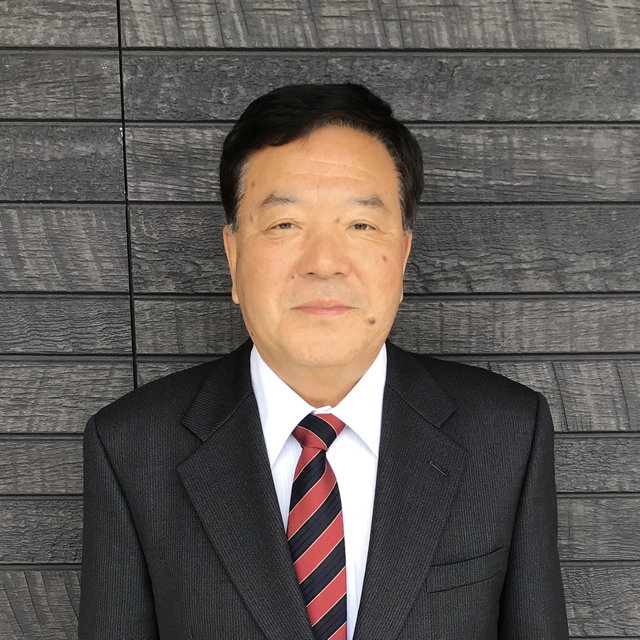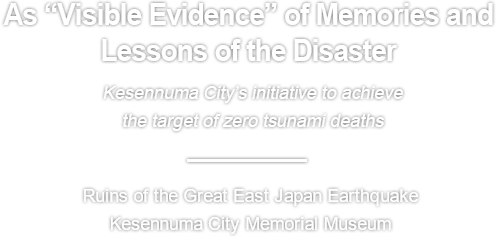Hours(Oct.–Mar.)
9:30 am to 4 pm (last entry at 3 pm)
The Great East Japan Earthquake on March 11, 2011, and the consequent great tsunami and widespread fires caused Kesennuma City to experience an absolute tragedy, with 1,143 people killed (including deaths in the disaster aftermath) and 212 people still missing.
The goal of the Ruins of the Great East Japan Earthquake Kesennuma City Memorial Museum is to preserve the memories and lessons of the disaster for the future and serve as “visible evidence” that continues ringing alarm bells, contributing to Kesennuma City’s initiative to achieve the target of zero tsunami deaths.

Greetings from
the director

It is a great honor for me to be appointed director of the Ruins of the Great East Japan Earthquake Kesennuma City Memorial Museum as of April 1, 2024.
When the Great East Japan Earthquake occurred, I was off-duty and at home. However, as a staff member of the Minamisanriku Fire Department, which was located in the neighboring town of Kesennuma City, I rushed to the department’s building soon after the earthquake struck. Seeing all the documents and even computers scattered across the floor, I immediately recognized the magnitude of the disaster. Other staff members also arrived one by one, and we felt extremely uneasy and tense.
Then the building was hit by a massive tsunami. I evacuated to the second floor but was caught by a wave and swept away. Three hours later I was lucky enough to be rescued by local residents in a place near Togura Junior High School, which was about four kilometers away from the building where I started. To my sorrow, however, the huge tsunami took the lives of 10 of my colleagues. Although 13 years have passed since the disaster, I still can’t help but think back to that day with regret, wishing I had urged my colleagues more loudly to “Get out!” My mind often flashes back to all the days that I spent with them.
The Ruins of the Great East Japan Earthquake Kesennuma City Memorial Museum was constructed on the site where Kesennuma Koyo High School used to be. The museum displays the ruins of the school to show the devastation caused by the earthquake and subsequent tsunami.
I regard the museum as a place for personal development, where visitors can experience through their senses of sight, hearing and others what it means to face a natural disaster, which I hope will help them recognize the importance of independent thought and action in their ordinary lives. Along with the rest of the staff, I look forward to welcoming many more visitors to the museum.
Finally, on behalf of everyone here at the museum, I would like to express our heartfelt sympathies to the victims of the Noto Peninsula Earthquake and our deep condolences to those who lost their lives in the disaster and their bereaved families.
Junnosuke Oikawa Director
Ruins of the Great East Japan Earthquake
Kesennuma City Memorial Museum
Facility Information
Ruins of the Great East Japan Earthquake Kesennuma City Memorial Museum
| Location | 9-1 Hajikamisemukai, Kesennuma City, Miyagi Prefecture 998-0246 Japan | ||
|---|---|---|---|
| TEL | 0226-28-9671 | FAX | 0226-28-9675 |
| info@kesennuma-memorial.jp | |||
| Nearest station | Rikuzen-Hashikami Station on the JR Kesennuma Line | ||
Hours
Apr.–Sep.9:30 am to 5 pm (last entry at 4 pm)
Oct.–Mar.9:30 am to 4 pm (last entry at 3 pm)
Closed
- Mondays (If a Monday falls on a national holiday, the facility will be open that day and be closed the next day.)
- Year-end and New Year holidays (December 29 to January 4)
Special days
※Days when the facility is open regardless of the day of the week or holiday status
- 11th of every month
- September 1 (Disaster Prevention Day)
- November 5 (World Tsunami Awareness Day)

